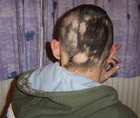Alopecia

Hair loss, also known as alopecia, is quite common. It is seen in men, women and children. Normally, hair growth occurs in a cycle. There are three main phases of the hair growth cycle, that is anagen, catagen and telogen. Anagen is when the hair fiber is produced, followed by catagen, a period of controlled regression of the hair follicle. Then the hair follicle enters telegon where it is in a resting place. You can lose approximately 50 to 100 hairs a day and feel fairly confident that it is normal. However, if you experience a steady loss of more than this, it is important to see a trichologist or a medical doctor to have the situation diagnosed. Sudden onset of hair loss can be discussed with a professional. Hair loss may be temporary depending on its cause, such as if it were caused by illness or a dramatic change in diet, or taking or stopping a given medication. The body eventually balances itself, and hair growth should return to normal. Diffusion of hair loss, which may occur all over the head or in patches, is not possible to correct or balance itself without qualified help. It will not be cured until its cause – often found to include a hormonal imbalance or mineral deficiency, or anemia – is diagnosed and treated. Permanent hair loss can result from genetic factors, such as male or female pattern of baldness, as well as specific forms of alopecia, especially traction alopecia. Typical male pattern baldness involves a receding hairline and eventually there is a horseshoe ring of hair around the sides. Female pattern baldness involves a thinning throughout the scalp which the front side of the hair remains intact.
Possible Causes For Hair Loss:
- Hormonal imbalances (maybe due to childbirth, birth control pills or thyroid disease).
- Anaemia
- Mineral imbalances
- Exposure to poisons (heavy metals, pesticides, and so on).
- X-rays
- Many forms of drugs.
- Liver and kidney disease.
- Autoimmune disease.
- Stress.
- Poor diet, including severe forms of food deprivation such as anorexia nervosa. Genetic, hereditary thinning or balding (androgenetic alopecia).
- Tinea capitis (ringworm of the scalp).
- Excessive shampooing and blow-drying.
- Burns or radiation therapy.
Hidden Causes Of Alopecia:
- Severe illness
- Severe emotional stress
- Menopause
- Certain hormonal disorders.